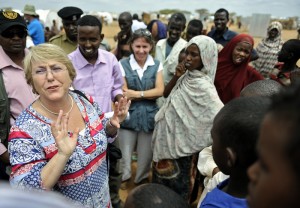UN Leaders Raise Alarm on Plight of Somali Refugees in Kenya
Date:
PRESS RELEASE
For immediate release
Dadaab, Kenya, 3 April 2011 — The heads of three United Nations agencies today expressed deep concern about the living conditions of more than 314,000 Somali refugees during a visit to three camps in Dadaab in northeastern Kenya. More refugees are arriving daily, crowding more people into one of the largest refugee concentrations in the world.
Drought and two decades of violence have forced Somalis to flee their country and take refuge at the three Dadaab camps, which were originally designed to accommodate a total of 90,000 people.

“After more than 20 years of war, Somali refugees have become a true global population, said UN High Commissioner for Refugees António Guterres. “The majority are here in Kenya and in Djibouti, Yemen and Ethiopia, but Somalis have sought refuge in countries on all five continents. As the war continues unabated, I appeal to all countries in the world to keep their borders open and to allow them to live in dignity.
He appealed to the government to allow the completion of an additional refugee residential area in Dadaab known as “Ifo II.
“Today I met Somali women and children who have fled conflict and arrived traumatized and suffering from malnutrition, said WFP Executive Director Josette Sheeran. “It is vital that we as United Nations agencies are here to protect them and provide the food and shelter they need as refugees in Dadaab.
The high concentration of refugees in an already harsh environment has had a negative impact on the camp surroundings. The United Nations and other groups are working with villagers from surrounding areas to find sustainable local solutions such as water and soil conservation.
To avoid the surrounding land being stripped bare in the search for firewood, humanitarian agencies have given refugees energy-saving stoves that use less fuel.
Poor hygiene and sanitation as a result of congestion in the camps exposes refugees to health hazards and security threats. In some cases, one toilet is shared by about 300 people.
Women and children are particularly vulnerable even when they reach the Dadaab camps.
“In addition to having to flee from their homes, women are exposed to sexual violence, said Michelle Bachelet, Executive Director of UN Women. “We must continue to do our utmost to protect girls and women, while also supporting their contribution as productive community members.
On top of rising tension in the camps because of overcrowding, UN agencies are alert to the possibility of an influx of more refugees from neighbouring countries and the potential impact this has on regional security.
For more information please contact:
- WFP/Dadaab, Peter Smerdon, peter.smerdon[at]wfp.org, +254 733 528 911, or Rose Ogola, +254 733 501 906; WFP/Nairobi, Stephanie Savariaud, stephanie.savariaud[at]wfp.org, +254 733 528 912
- UNHCR Spokesperson Melissa Fleming, fleming[at]unhcr.org, +41 79 557 9122
- UN Women Media Specialist Oisika Chakrabarti, oisika.chakrabarti[at]unwomen.org, +1 646 781-4522; UN Women/Nairobi, Mohammed Duba, mohammed.duba[at]unwomen.org, +254 725 436 494